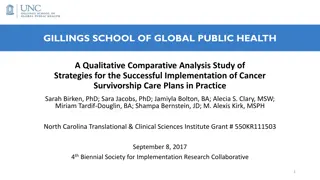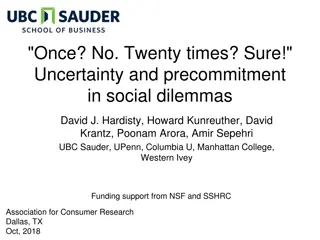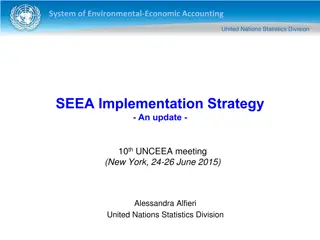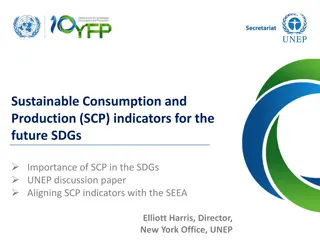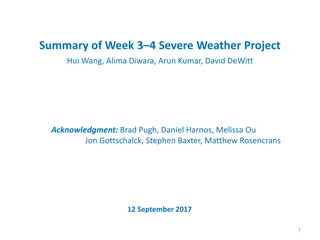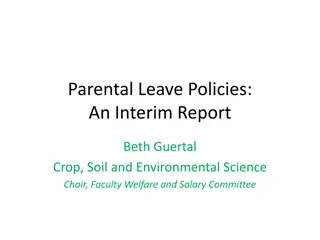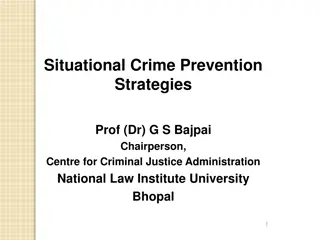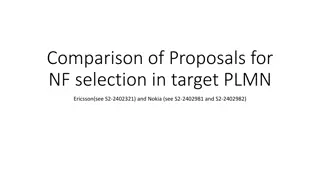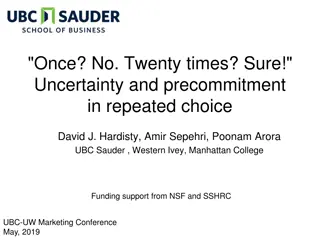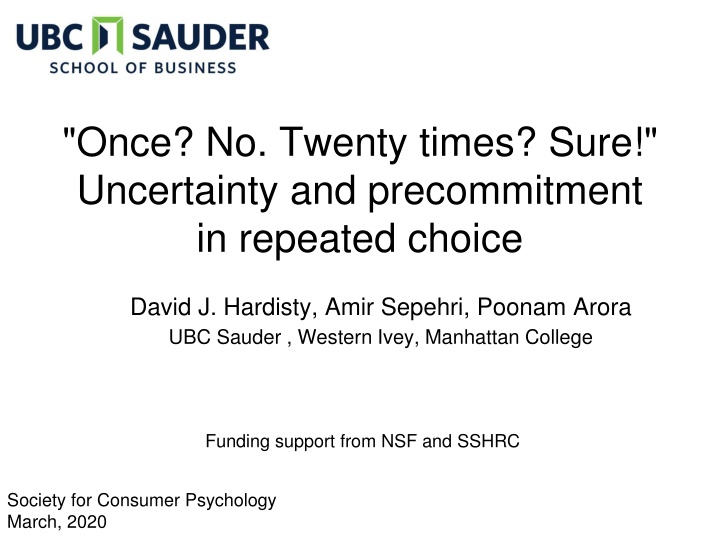
Uncertainty and Precommitment in Decision Making
Dive into research exploring uncertainty and precommitment in repeated choice scenarios, shedding light on decision-making processes and the impact of subjective probability over time. Discover how individuals grapple with rare events and navigate decision-making involving low probability occurrences. Explore insights on nudging people towards long-term thinking through precommitment strategies.
Download Presentation

Please find below an Image/Link to download the presentation.
The content on the website is provided AS IS for your information and personal use only. It may not be sold, licensed, or shared on other websites without obtaining consent from the author. If you encounter any issues during the download, it is possible that the publisher has removed the file from their server.
You are allowed to download the files provided on this website for personal or commercial use, subject to the condition that they are used lawfully. All files are the property of their respective owners.
The content on the website is provided AS IS for your information and personal use only. It may not be sold, licensed, or shared on other websites without obtaining consent from the author.
E N D
Presentation Transcript
"Once? No. Twenty times? Sure!" Uncertainty and precommitment in repeated choice David J. Hardisty, Amir Sepehri, Poonam Arora UBC Sauder , Western Ivey, Manhattan College Funding support from NSF and SSHRC Society for Consumer Psychology March, 2020
Major revision Paper has split in two and now has a different theory (sorry Stephen!) Main finding is robust but process is unclear Criticisms and suggestions welcome
Decision Making with Rare Events Poor decision making with low probability events: Data backup Extreme weather events (e.g., earthquake, flood) Nighttime visibility
Research Motivation Normally, greater delay is associated with increased uncertainty example: $10 promised today or in a year However, with repeated low probability events, increasing time horizon may increase subjective probability Example (choice bracketing): Wear your seatbelt? Chance of injury this time vs lifetime (Slovic, Fischhoff, & Lichtenstein, 1978)
How to nudge people to think long-term? People sometimes precommit to invest in protection for several time periods in advance examples: Binding commitments: long-term insurance contracts Non-binding commitments: safety decisions (seat-belt, helmet, etc) Social dilemmas: CO2reductions
Why Precommitment? Slovic et al. 1978 Read et al. 1999 Choice Bracketing Scale Design as a Choice Architecture Tool Camilleri & Larrick, 2014 Precommitment Description vs. Experience of Risk Hertwig, Barron, Weber, & Erev, 2004 Kahneman & Tversky, 1979 Integrating losses Intertemporal Uncertainty Avoidance Hardisty & Pfeffer, 2017
Theory 1: Subjective Probability Subjective probability (of large loss) + Time horizon + + + Preference for safer option Precommitment Intuitively plausible Not supported by any self-report measures Not supported by some behavioral measures
Theory 2: Multiple Goals One choice at a time goal is to do well on that choice disregard low probability events Precommiting to multiple choices goals to do well on each choice and to do well overall upweight low probability events
Theory 2: Multiple Goals Upweight low probability events + + Time horizon Long-term goal + + + Preference for safer option Precommitment Consistent with behavioral results Too fuzzy Currently collecting process data
Study 1 Question: Do individuals choose the safe option more often when they precommit their choices?
Design Overview Participants (N=60 students) played 4 blocks of 20 rounds ( years ) Between subjects: repeated vs precommited choice DV: Choice to invest in protection (small, certain loss) or take a risk of a large loss Full instructions & comprehension test 1 block paid out for real money
Instructions (pg 1) Imagine you are an investor in Indonesia and you have a risky venture that earns 8,500 Rp per year. However, there is a small chance that you will suffer a loss of 40,000 Rp in a given year. You have the option to pay 1,400 Rp for a safety measure each year to protect against the possible loss. You will be fully protected if you invest in protection. The loss has an equal chance of happening each year, regardless of whether it occurred in the previous year.
Choice - You definitely lose 1,400 Rp, and have a 0% chance of the large loss occurring. - You have a 4% chance of losing 40,000 Rp and a 96% chance of losing 0 Rp. INVEST NOT INVEST
Choices: Repeated Condition Will you invest in protection this year? INVEST | NOT INVEST
Choices: Precommited Condition Will you invest in protection in year 1? INVEST | NOT INVEST ~~~~~~~~~~~~~~~~~~~~~~~~~~~~~~~~~~~~~~~~~~~~~~~~~~~~~~~~~~~~~~~~~~~~~~ Will you invest in protection in year 2? INVEST | NOT INVEST ~~~~~~~~~~~~~~~~~~~~~~~~~~~~~~~~~~~~~~~~~~~~~~~~~~~~~~~~~~~~~~~~~~~~~~ Will you invest in protection in year 3? INVEST | NOT INVEST ~~~~~~~~~~~~~~~~~~~~~~~~~~~~~~~~~~~~~~~~~~~~~~~~~~~~~~~~~~~~~~~~~~~~~~ Will you invest in protection in year 4? INVEST | NOT INVEST ~~~~~~~~~~~~~~~~~~~~~~~~~~~~~~~~~~~~~~~~~~~~~~~~~~~~~~~~~~~~~~~~~~~~~~ Will you invest in protection in year 5? INVEST | NOT INVEST ~~~~~~~~~~~~~~~~~~~~~~~~~~~~~~~~~~~~~~~~~~~~~~~~~~~~~~~~~~~~~~~~~~~~~~ [...] Will you invest in protection in year 20? INVEST | NOT INVEST
Feedback Year 1 Results Your choice: INVEST The random number was: 88 This Means The large loss: did not occur Result: You lost 1,400 Rp.
Feedback Year 2 Results Your choice: NOT INVEST The random number was: 3 This Means The large loss: occurred Result: You lost 40,000 Rp.
Study 1 Results 1 Investment Proportion 0.9 0.8 0.7 0.6 0.5 Repeated Precommitted 0.4 0.3 0.2 0.1 0 Block 1 Block 2 Block 3 Block 4
Self-report Data Across studies, self-report: the likelihood that a loss would occur at least once in 20 rounds (___%) How likely is the big loss? (1-7 scale) How worried are you about the big loss? (1-7 scale) Always null results!
Study 2 Question: How does a change in the Decision-Maker time horizon affect preferences in repeated and precommited choice?
Study 2: Theory If precommitment increases time horizon, then experimentally increasing the time horizon should have the same effect and should wipe out the effect of precommitment
Study 2 N=567 Mturkers, hypothetical Repeated vs Precommitted Time horizon manipulation (vs no-instruction control): Think about all the 20 rounds of the game. What is the best strategy? How many rounds out of 20 you think you should invest?
Study 2: Results 0.6 Mean investment proportion in 0.5 0.4 safe option 0.3 0.2 0.1 0 Repeated DM Time Horizon: Control DM Time Horizon: Aggregate Precommited
Study 2: Summary Urging participants to think about all 20 rounds of the game: Increased the choice of safe option in the repeated condition. Did not have any effect in the precommitment condition. Further supports the increase in time- horizon account.
Study 3 Question: What if pre-commitment isn t binding?
Study 3: Theory If precommitment increases time horizon, then non-binding precommitment should have the same effect
Study 3 N=210 MTurkers Repeated vs Precommitted vs. non- binding precommitted Key difference: Ability to change precommitted choices after each round
Study 3: Results 0.6 Mean investment proportion 0.5 0.4 0.3 0.2 0.1 0 Repeated Precommitted Non-binding Precommitted
Study 3: Summary Non-binding precommitment is roughly as effective as the binding precommitment. Supports the time horizon story Rules out differences in feedback timing as an explanation
Study 4: Methods IV: Number of rounds in each block: 20 vs 10 vs 5 Subjective Probability Prediction: pre- commitment should be less effective with shorter blocks Multiple Goals Prediction: block length doesn t matter
Study 4: Results Repeated 1 Precommitted Mean investment proportion 0.8 0.6 0.4 0.2 0 20 10 5 Number of rounds
Study 4: Summary The effect of precommitment is equally strong for shorter vs longer block lengths This contradicts the subjective probability theory This is consistent with the multiple goals theory
Study 5: Methods & Theories Probability education intervention: 4% chance of losing 40,000 (this means that there is a 56% chance of the 40,000 payment happening at least once during 20 months) Subjective Probability Prediction: education should increase investment rates, and decrease the effect of precommitment Multiple Goals Prediction: No effect
Study 5: Results 1 Mean investment proportion 0.8 0.6 0.4 0.2 0 Control Repeated Education Precommitted
Study 5: Summary Education slightly increases investment rates (replication of Slovic, Fischhoff, & Lichtenstein, 1978) Precommitment has a larger effect, and is not changed by education This suggests procommitment changes goals, rather than probability perceptions
Study 6: IDS Interdependent Security (IDS) is a social dilemma with stochastic losses (Kunreuther & Heal, 2003) disease control (COVID-19, anyone???) border security risky investments People typically cooperate less in IDS than in a deterministic Prisoner s Dilemma
IDS payoff matrix Your Counterpart NOT INVEST - You definitely lose 1,400 Rp and have a 1% chance of losing an additional 40,000 Rp. INVEST - You definitely lose 1,400 Rp, and have a 0% chance of the large loss occurring. You INVEST - Your counterpart definitely loses 1,400 Rp, and has a 0% chance of the large loss occurring. - You have a 3% chance of losing 40,000 Rp and a 97% chance of losing 0 Rp. - Your counterpart has a 3% chance of losing 40,000 Rp and a 97% chance of losing 0 Rp. NOT INVEST - You have a 4% chance of losing 40,000 Rp and a 96% chance of losing 0 Rp. - Your counterpart definitely loses 1,400 Rp and has a 1% chance of losing an additional 40,000 Rp. - Your counterpart has a 4% chance of losing 40,000 Rp and a 96% chance of losing 0 Rp.
PD payoff matrix Your Counterpart NOT INVEST - You lose 1,800 Rp. - Your counterpart loses 1,200 Rp. INVEST - You lose 1,400 Rp. - Your counterpart loses 1,400 Rp. You INVEST NOT INVEST - You lose 1,200 Rp. - Your counterpart loses 1,800 Rp. - You lose 1,600 Rp. - Your counterpart loses 1,600 Rp.
Study 6: Additional Design Details N=120 students Incentive compatible 4 blocks of 20 rounds each Anonymous pairs Randomly paired before each block
Study 6: Deterministic vs Stochastic Prisoners Dilemma 1 0.9 Mean Investment 0.8 0.7 Proportion 0.6 0.5 0.4 0.3 0.2 0.1 0 DPD SPD Precommitment Repeated
Study 7 Question: How does non-binding precommitment operate in Social dilemmas?
Study 7 Stochastic Prisoners dilemma (IDS) N=160 paid pool participants (students) IV: Repeated vs Precommitted vs. non- binding precommitted 1 block paid for real money
Study 7 payoff matrix Your Counterpart NOT INVEST - You definitely lose 1,400 Rp and have a 1% chance of losing an additional 40,000 Rp. INVEST - You definitely lose 1,400 Rp, and have a 0% chance of the large loss occurring. You INVEST - Your counterpart definitely loses 1,400 Rp, and has a 0% chance of the large loss occurring. - You have a 3% chance of losing 40,000 Rp and a 97% chance of losing 0 Rp. - Your counterpart has a 3% chance of losing 40,000 Rp and a 97% chance of losing 0 Rp. NOT INVEST - You have a 4% chance of losing 40,000 Rp and a 96% chance of losing 0 Rp. - Your counterpart definitely loses 1,400 Rp and has a 1% chance of losing an additional 40,000 Rp. - Your counterpart has a 4% chance of losing 40,000 Rp and a 96% chance of losing 0 Rp.
Study 7: Results 0.7 0.6 Investment Proportion 0.5 0.4 0.3 0.2 0.1 0 Block 1 Block 2 Block 3 IDS Repeated IDS Precommitted IDS Non-binding
Study 7: Summary Replication of precommitment effect in a stochastic social dilemma. Non-binding precommitment is not as effective when there is a counterpart involved.
Conclusions In repeated choice with large, low- probability losses, precommitment increases investment in protection because precommitment activates a long-term goal (?) In interdependent security, precommitment increases cooperation In regular prisoners dilemma, precommitment reduces cooperation




